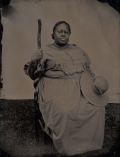 (photo: Angela da Silva is pictured as a slave named "Lila" in an old tintype style of photograph. She will be the featured speaker at dedication for a bust of former Missouri U.S. Sen. John Brooks Henderson of Louisiana, who introduced the 13th Amendment outlawing slavery).
(photo: Angela da Silva is pictured as a slave named "Lila" in an old tintype style of photograph. She will be the featured speaker at dedication for a bust of former Missouri U.S. Sen. John Brooks Henderson of Louisiana, who introduced the 13th Amendment outlawing slavery).
Angela da Silva promises an unforgettable interpretation of voices from the past that still carry relevance. The Lindenwood University adjunct professor will portray a slave woman named “Lila” at the dedication of a bust honoring Louisiana lawmaker John Brooks Henderson, who drafted and introduced the 13th Amendment outlawing slavery. The ceremony at 1 p.m. Wednesday, July 4, in Henderson Riverview Park is open to the public. The portrayal will provide “a very realistic view of slavery,” da Silva said. “I’m not trying to sanitize it. This is what happened to the average black slave woman in Missouri.”
As a girl, da Silva listened to the stories her elders told. Her mother’s family included slaves who lived near Jonesburg. On her father’s side, there were slaves who toiled in Overland. “I remember listening intently and asking what a slave was,” she said. “From then on, I was fascinated.”Throughout high school and college, da Silva continued researching the subjugation of African Americans in Missouri and elsewhere “It was always a passion,” she said. About 15 years ago, da Silva began depicting Lila as part of a history program in the Rockwood School District. Students found the presentation so captivating that they’d ask her if she had ever been “freed.”
The character is a cook who is in her early 50s and has been “sold” several times before being “bought” by an owner in St. Louis. Lila is a composite of several women, but da Silva points out their voices are documented as being those of slaves. The re-enactor says she likes to “blur that line” between reality and portrayal during her performances as a way of getting emotional responses that will stay with audiences long afterward. And she doesn’t hold back the horrors of human bondage.“It’s amazing they survived,” da Silva said.
Lila also is brought to life at programs throughout the Midwest, and da Silva performs the second Sunday of each month at the Historic Daniel Boone Home at Lindenwood Park in Defiance. She doesn’t like that history too often is taught “one-dimensionally” using little more than names and dates. “What we forget is those people living in their time are just that – people,” she said. “We don’t talk about the people themselves.”
Da Silva’s appearance will be especially purposeful in Louisiana. Just two years before Henderson was appointed to the U.S. Senate, almost one of every five Pike County residents was owned by somebody else. As a boy, Henderson witnessed slave auctions. Though he could never fully understand what it meant to be held against his will, he did experience “involuntary servitude” after being orphaned at 10 and hired out to a farmer until he was 18.
Henderson arrived in Washington in 1862, and quickly became a Lincoln confidant. The Constitution had not been changed in almost 60 years, and the prevailing thought was that slavery was an issue best left to state legislators. Lincoln, Henderson and others elevated abolition to a federal level. The senator argued the Civil War would be in vain if slavery continued. “Truth and error cannot be reconciled,” he said. “Right and wrong cannot dwell together in peace.” Research by Gary Gene Fuenfhausen indicates that Pike County had the seventh-largest Missouri slave population in 1860 at 4,055. The census that year showed 18,417 residents. Since slaves were not part of the general count, the county’s combined population would be 22,472. That means 18 percent of the total was someone’s property.
Henderson once owned slaves, likely through an inheritance, but freed them. Several drafts eventually were combined to form the 13th Amendment, but the final wording was closest to Henderson’s original. He introduced the proposal on Jan. 11, 1864. Congress approved it a year later and Lincoln, though he didn’t have to, added his signature. The document took effect on Dec. 18, 1865. After the July 4 ceremony, da Silva will take questions in the park’s shelter house. Also speaking will be Louisiana Mayor Marvin Brown and artist John Stoeckley, who designed and created the 27-inch bust, which will sit atop a base that’s a little over four feet tall. Henderson and his wife, Mary, deeded land for the park to the city in 1903.